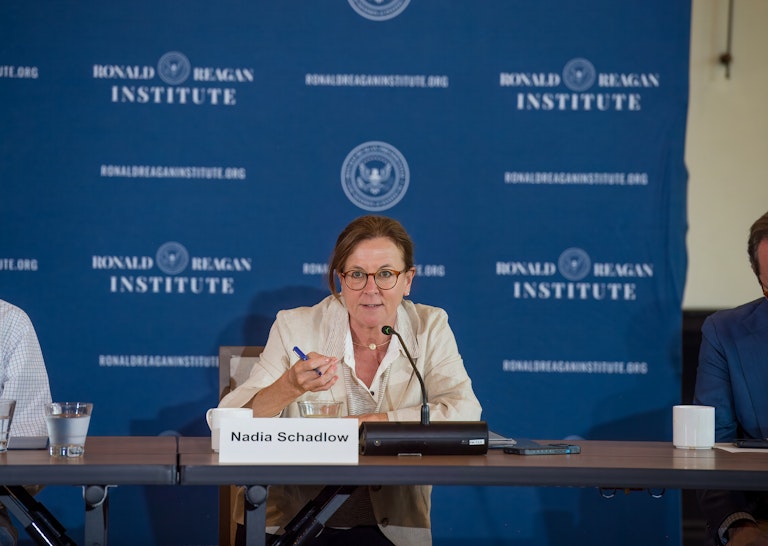Ronald Reagan Institute
The Trump Administration’s Foreign Policy Goals: A Hemispheric Defense of U.S. Interests
By Nadia Schadlow

In May of 2025, Chinese President Xi Jinping hosted his fourth summit with leaders from Latin America and the Caribbean (LAC). Representatives from 28 countries listened as Xi launched five new programs, which, according to the Chinese Communist Party (CCP), intended to “consolidate political foundation, promote common prosperity, deepen mutual learning between civilizations, promote regional stability and people-to-people friendship which points the direction for the building of a China-LAC community with a shared future.”1
This meeting signaled China’s increasing ties with countries in the Western Hemisphere over the last decade through infrastructure, trade, and diplomacy. It also demonstrated that China is not “staying in its lane,” but seizing advantages globally, often at the expense of the United States.
This paper will argue that the United States needs to strengthen its hemispheric defense and relationships—but also maintain its ability to operate across regions of the world. While I agree with Gray’s general argument that Washington needs to shift attention back to the Western Hemisphere, such a move is less about reprioritization and more about rebalancing.
Hemispheric Strength
Gray points out that the Trump Administration must take the long-neglected opportunity to focus more on securing U.S. interests in the Western Hemisphere. He accurately describes Washington’s “benign neglect” of the region. Because of U.S. capabilities after WWII, its national prosperity was no longer reliant on an interconnected and fortified hemisphere. Instead, it could seek economic opportunities and forward defensive positions abroad. The resulting conventional wisdom held that since the United States was no longer a developing republic threatened by encroaching empires, the concerns underlying the Monroe Doctrine were less relevant. Therefore, the United States turned its attention away from its own neighborhood, which it had already pacified through decades of regional dominance, to focus on shaping and maintaining a U.S.-led international order.
As a result, Washington has not adequately addressed developments and crises near U.S. borders for nearly a century, but particularly since the end of the Cold War. This neglect has enabled American adversaries, primarily Russia and China, to amass increased political, economic, and military influence in the region.
Russia has strengthened ties with authoritarian regimes in Cuba, Nicaragua, and Venezuela. It is especially problematic that Russia, often alongside China, has used its veto power in the UN Security Council to block resolutions pressuring President Nicolas Maduro’s Venezuelan government or calling for new elections. As one expert put it, without Russia, China, and Cuba’s continued support, it is unlikely Maduro’s government would have lasted as long.[ii]
China has also made inroads into the region with its neo-mercantilist Belt and Road Initiative (BRI), which seeks to achieve both security of supply and global market access through domination of key sectors, including agricultural production and extractive industries. [iii]
With President Trump’s election and the rightward political shifts in the region, new opportunities have emerged. As Secretary of State Rubio remarked:
For too long, the U.S. has ignored its strongest allies in Latin America. That is changing. We are now focusing on those who share our values of democracy, economic freedom, and human rights.[iv]
Washington can work with partners in Latin America to reinforce U.S. national security, deepen economic cooperation, and combat foreign influence. For instance, the Bukele government in El Salvador is already supporting U.S. national security by accepting suspected gang members who are illegally in the United States.[v] President Javier Milei of Argentina has committed to deepening U.S.-Argentine diplomatic and economic ties.[vi] The United States can use regional partnerships such as these to counteract the deeply entrenched political-economic influence that Russia and China have been cultivating for years.
Additionally, many Latin American nations—even those that sent representatives to the Beijing summit—are increasingly frustrated with China. In early 2025, Panamanian President José Raúl Mulino expressed skepticism about the BRI’s supposed benefits, asking, “What great things has it brought to Panama over the years? What has the Belt and Road Initiative contributed to the country?” He added that Panama would let the 2017 trade and development pact expire and instead seek U.S. investment.[vii]
Nevertheless, China continues to flood many developing economies with cheap goods,[viii] which puts pressure on poorer countries trying to expand their own manufacturing.[ix] Brazil is still seen as the “world’s backyard for China to send materials.”[x] Washington has the chance to present a better economic alternative.
The Prioritization Argument
Gray and I agree that the United States should do more in the Western Hemisphere. Our main point of disagreement is over the extent of U.S. prioritization of Latin America and the Arctic relative to other global theaters.
The “prioritization” school of foreign policy asserts that the United States must recognize two hard truths: its military power is limited and resources are inherently scarce. Prioritizers argue that the United States should allocate most of its military, diplomatic, and economic resources to regions most critical to national interests. Scarcity demands that Washington shift resources away from deprioritized regions, even if they still hold substantial value.[xi]
The problem with this argument is that adversaries are likely to react to a reduced American presence in a particular region by filling the void. Geopolitical strategies are not “plans” per se; they are not straightforward lists of desired outcomes. Instead, they involve action and reaction cycles. As President Nixon realized, Washington should maintain an equilibrium in the world because other self-interested countries seek opportunities created by inattention.
Prioritizers are most concerned about China[xii]—but they often assume that China will stay in its geographic lane. Yet China has repeatedly demonstrated that it seeks to increase its influence across regions as part of its global strategy to usurp the United States globally. The CCP’s core geopolitical objective—as expressed in speeches like President Xi’s “China Dream” speech, and in policy documents such as “Made in China 2025”—is to increase its cross-regional influence by creating global dependencies on Chinese manufacturing, technology, and infrastructure investment.
China’s current push back against the Panama deal illustrates its global strategy. The CCP has purportedly pressured the Hong Kong company, Hutchison Ports, which began operating ports in Panama in 1997, to halt the sale of the two ports.[xiii]
The Changing Nature of Hemispheric Defense
Gray correctly traces the historical roots of the Roosevelt Administration’s “hemispheric defense” strategy during WWII and then discusses the need for a “reimagined” Monroe Doctrine that would preserve a regional power balance by partnering with local allies to exclude adversarial foreign influence. As President Trump noted in his 2018 UN General Assembly speech: “It has been the formal policy of our country since President Monroe that we reject the interference of foreign nations in this hemisphere and in our own affairs.”[xiv] President Trump’s approach to Greenland and the Panama Canal is a response to increasing threats from U.S. adversaries in the Western Hemisphere
Gray is correct that reimagining aspects of the Monroe Doctrine is beneficial to U.S. national security. But it is not enough. Hemispheric defense was not solely or even primarily responsible for the successful defense of the American homeland during WWII. Rather, the U.S. war effort largely succeeded through proactive military, economic, and diplomatic efforts undertaken abroad. The same is, and will continue to be, true today.
Successful hemispheric defense is extraterritorial. Our ability to defend the American homeland will depend upon a range of strategies and tools that will require engagement beyond our hemisphere. Technology such as drones can help us better defend our long Southern border, but it also holds us vulnerable to threats that emanate outside of our closest region. American strength in the Western Hemisphere is a necessary but not sufficient component of U.S. grand strategy.
[i] The programs are: the Solidarity Program, the Development Program, the Civilization Program, the Peace Program, and the People-to-People Program. See Bill Bishop, “China-CELAC Forum; Xi and Lula; More policy support for tech financing; Solar shutdown risk? Huawei chips; Death by baijiu,” Sinocism
, May 14, 2025, https://sinocism.com/p/china-celac-forum-xi-and-lula-more?open=false#%C2%A7china-community-of-latin-american-and-caribbean-states-celac-forum.
[ii] CFR 2019 report
[iii] CSIS 2020 report
[iv] “Secretary of State Marco Rubio Discusses Regional Challenges in Exclusive Interview with SIN News,” Foreign Policy Watchdog, February 13, 2025, https://foreignpolicywatchdog.com/united-states/secretary-of-state-marco-rubio-discusses-regional-challenges-in-exclusive-interview-with-sin-news.
[v] Zolan Kanno-Youngs et al., “Behind Trump’s Deal to Deport Venezuelans to El Salvador’s Most Feared Prison,” New York Times, April 30, 2025, https://www.nytimes.com/2025/04/30/us/politics/trump-deportations-venezuela-el-salvador.html.
[vi] Ariel González Levaggi & Claudio Robelo, “Argentina’s Realignment with the United States: Milei’s Reforms Gain Strategic Support,” Center for Strategic & International Studies, April 30, 2025, https://www.csis.org/analysis/argentinas-realignment-united-states-mileis-reforms-gain-strategic-support.
[vii] Diana Glebova, “Panama to end relationship with China’s premier foreign investment program after US pressure,” New York Post, February 3, 2025, https://nypost.com/2025/02/03/us-news/panama-to-end-relationship-with-chinas-belt-and-road-initiative/.
[viii] Jason Douglas et al., “China’s Flood of Cheap Goods Is Angering Its Allies, Too,” Wall Street Journal, December 3, 2024, https://www.wsj.com/world/china/chinas-flood-of-cheap-goods-is-angering-its-allies-too-51284954.
[ix] Igor Patrick, “Brazil imposes new tariffs on imports from China in bid to fight dumping,” South China Morning Post, October 19, 2024, https://www.scmp.com/news/china/diplomacy/article/3283014/brazil-imposes-new-tariffs-imports-china-bid-fight-dumping.
[x] Mariana Durao and James Attwood, “China Is Seen as More Menacing Than US Tariffs for Latin America's Steelmaker,” Bloomberg, March 13, 2025, https://www.bloomberg.com/news/articles/2025-03-13/csn-says-chinese-steel-influx-a-bigger-issue-than-us-tariffs.
[xi] Alex Velez-Green and Robert Peters, “The Prioritization Imperative: A Strategy to Defend America’s Interests in a More Dangerous World,” Heritage Foundation, August 1, 2024, https://www.heritage.org/defense/report/the-prioritization-imperative-strategy-defend-americas-interests-more-dangerous.
[xii] Elbridge Colby, “America Must Face Reality and Prioritise China over Europe,” Financial Times, May 23, 2024, https://www.ft.com/content/b423aa65-b9cb-4ba5-9c7d-f67dc289a18f; Elbridge Colby, “Only One Priority Makes Sense for American Foreign Policy,” American Compass, July 10, 2024, https://americancompass.org/only-one-priority-makes-sense-for-american-foreign-policy/.
[xiii] Oiwan Lam, “China halts Hong Kong-based Hutchison's port deal with US-led consortium in Panama,” Global Voices, March 31, 2025, https://globalvoices.org/2025/03/31/china-halts-hong-kong-based-hutchisons-port-deal-with-us-led-consortium-in-panama/.
Join Our Newsletter
Never miss an update.
Get the latest news, events, publications, and more from the Reagan Institute delivered right to your inbox.
